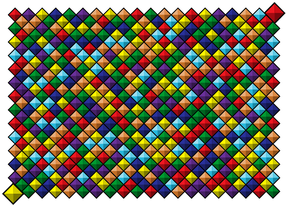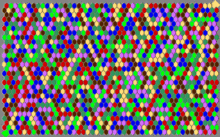Filler (game)
| Filler | |
|---|---|
| Publisher | Gamos |
| Senior Developer | Dmitry Pashkov |
| Erstveröffent- lichung |
1990 |
| platform | MS-DOS , Amiga , Atari , Windows , Linux , Android , ... |
| genre | Arcade game , board and thinking game |
Filler , also known as 7 Colors , is a simple computer strategy game . The game is played on a board with usually hundreds of rectangular or hexagonal fields displayed on a screen against one or rarely several opponents. The opponents are mostly generated by the computer, human opponents are usually always adjustable and can in principle also use the same hardware.
The aim of the game is to conquer more playing fields than the opponent (s). If a player has conquered more than half of all fields, he wins the game - even if there are still "neutral" fields.
Depending on the software implementation and the available screen size, the dimensions and shapes of the game board vary greatly. Most game boards usually have a rectangular basic shape, regardless of whether the individual fields are rectangular or hexagonal.
At the beginning of the game, each individual field is colored randomly. The number of colors available for this is determined in advance and is usually 4 to 10 colors. The game board is quite colorful at the beginning. Each player has a starting field, usually in a corner, which is also assigned a random color. It is possible that fields of the same color are adjacent to the starting field, these enlarge the starting territory (not in all variants). Fields adjoin each other when they touch one side.
New fields are conquered by the player taking on their color. A player can accept all colors available on the board, except for the current color of the opponent (s).
History and well-known programs
Filler was developed in 1990 by Dmitry Pashkov and released for MS-DOS by the Soviet / Russian game developer Gamos . The French game manufacturer Infogrames Entertainment marketed it in 1991 for Amiga , Atari and PC-98 as 7 Colors . The game is played on a rectangular board with 2086 rectangular fields that run diagonally and have a jewels- like appearance.
Alexander Vikulin implemented this idea with hexagonal fields under the name "Filler" in 1995 for Windows . The program was distributed as shareware . The computer opponent's artificial intelligence (AI) had three levels of difficulty, the highest level was only activated with the paid version. The board has 1378 hexagonal fields and can be played with 5 to 9 colors. The starting fields of the two players are freely configurable.
There is also a very similar program for Linux, even free of charge and under the DFSG -free license.
In addition, there were a wide variety of adaptations for a wide variety of platforms, and the distribution was usually quite low. These include simple programs for the DOS text mode and conversions with images instead of colors.
This game idea is now also available for smartphones and other modern devices and platforms. In Android are interesting here two programs: this is the one "Filler Game" from Caeex Developer. It offers both the hexagonal board design and the square one and, if desired, simulates a hexagonal board with offset square fields. It also offers several computer-simulated opponents whose AI uses different strategies.
On the other hand, it is “Quadratum” from Machaon studio. Up to 4 players play against each other on the square board (up to 3 with AI) and sometimes have to overcome obstacles.
Game strategy considerations
If you play filler against a human opponent, it makes sense to agree on a time limit per move, many programs offer this as an option.
There are several strategic approaches. For the sake of simplicity, the opponent is initially ignored. The most obvious strategy is to always adopt the color that promises the greatest immediate area gain. This approach is very simple and rarely successful as the number of colors increases.
For human gamers it is harder to overlook, but it is particularly useful for somewhat more complex computer-generated gamers to adapt the first approach. The color chosen is always the one that maximizes the number of adjacent unconquered fields. In this way, individual fields that are already included - and that are inaccessible by the opponent - are ignored. In addition, many border fields also mean many newly adjoining fields. In the course of the game and the constant change of the area color, these are conquered just like that - almost automatically.
The following basic idea is much more successful: This consists of building a “road” as far as possible towards the opposing starting field and using “roads” to separate large parts from the opponent. The trick is to see these “streets”, which mostly already exist as color bridges in their beginnings, and then to connect them.
A style of play is refined when the opponent is taken into account and when the next color is chosen, his best color is blocked if possible by accepting it yourself.



